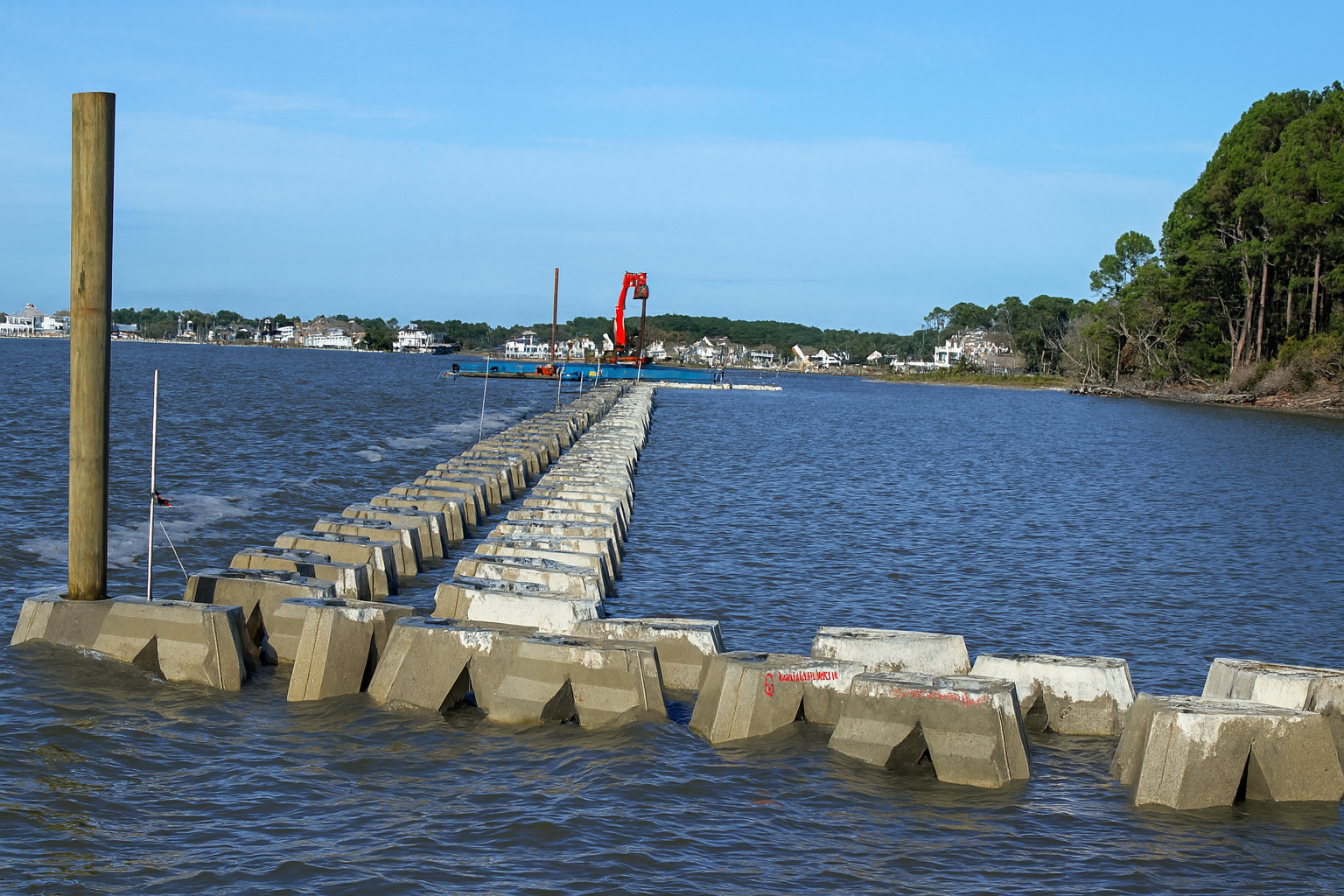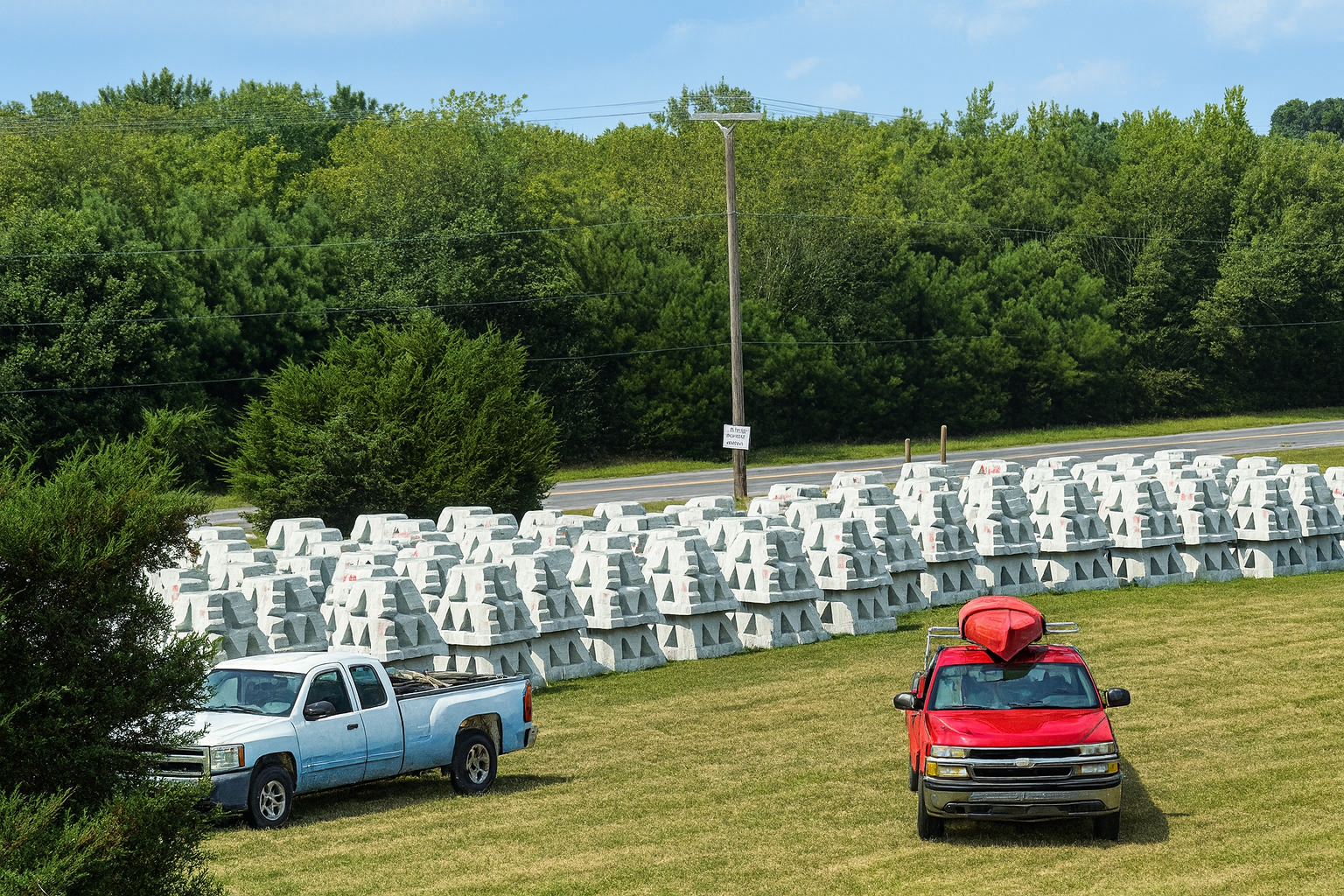The Delaware Center for the Inland Bays has officially begun the construction phase of the Thompson Island Living Shoreline Project, a large-scale initiative that will protect Thompson Island’s shoreline and strengthen the surrounding aquatic ecosystem.
The project, developed in partnership with DNREC, Delaware State Parks, Sovereign Consulting Inc., and other organizations, will see the installation of approximately 400 wave attenuation devices along the island’s coast.
These structures, placed from a barge and anchored in shallow waters, are designed to dampen wave energy and significantly reduce shoreline erosion.
By softening the impact of waves generated by wind and boats, the devices create calmer nearshore conditions that help maintain the shoreline’s shape and improve water clarity.
The calmer environment supports the growth of submerged aquatic vegetation and enhances habitats for fish, shellfish, and other marine life.

Image Generated by AI
Honoring the Cultural Heritage of Thompson Island
Thompson Island holds deep cultural and spiritual significance for the Nanticoke Indian Tribe.
For centuries, the island served as a ceremonial and gathering place and is considered sacred ground by tribal members.
When the site was officially dedicated as a nature preserve in 2000, the State of Delaware and the Nanticoke Tribe entered into an agreement ensuring the land would remain protected and accessible to the tribe while being managed by Delaware State Parks.
Representatives from the Delaware Center for the Inland Bays have emphasized their commitment to carrying out this project with respect for both the ecological and cultural importance of the site.
Addressing Erosion and Sea-Level Rise
Located at the intersection of the Lewes-Rehoboth Canal and Rehoboth Bay, Thompson Island is part of Delaware Seashore State Park and spans roughly 68 acres.
Over the years, the island has faced severe shoreline erosion, sea-level rise threats, and strong wave energy from storms.
Assessments have shown that the shoreline has been receding by as much as 0.8 feet per year.
The current 4,900-linear-foot restoration area includes the west, south, and eastern shores of the island.
Although the site is not open to the public and boats are prohibited from landing on its beaches, the progress of the project can be seen from the water and from Sunset Park in Dewey Beach.

Image Generated by AI
Goals and Expected Outcomes
The Thompson Island Living Shoreline Project is part of a broader effort by the Delaware Center for the Inland Bays to use nature-based methods for protecting coastlines.
These approaches improve water quality, provide habitat for wildlife, and strengthen the region’s resilience to climate change.
Key project goals include:
- Stabilizing the eroding shoreline of Thompson Island
- Reducing sediment and nutrient runoff into Rehoboth Bay
- Enhancing wetland and aquatic habitats
- Creating resilient protection against storms and rising sea levels
- Supporting spawning grounds for horseshoe crabs and nesting sites for terrapins
- Demonstrating living shoreline techniques for public education and contractor training
Unlike traditional hardened structures, such as bulkheads or riprap, the wave attenuation devices used in this project allow water and marine life to move freely.
Their open design reduces wave energy while encouraging the natural buildup of sediment that strengthens the shoreline over time.
Long-Term Environmental Benefits
One of the most promising aspects of the Thompson Island Living Shoreline Project is its long-term sustainability.
Living shorelines are among the few coastal stabilization solutions that actually become stronger as they age.
Over time, they attract shellfish, fish, birds, and native plants that reinforce the structure and improve biodiversity.
The Delaware Center for the Inland Bays will continue to monitor the island’s shoreline to ensure the project meets its goals.
With a potential lifespan of more than 25 years, this effort aims to create a self-sustaining system that enhances both ecological health and cultural preservation.

Image Generated by AI
A Shared Commitment to Delaware’s Inland Bays
This project reflects a shared vision among the Delaware Center for the Inland Bays, DNREC, the DNREC Division of Parks & Recreation, Restore America’s Estuaries, the U.S. Environmental Protection Agency, and Sovereign Consulting Inc.
Together, these organizations are advancing coastal resilience and ensuring that the region’s natural and cultural treasures are preserved for generations to come.
As Delaware continues to face the impacts of sea-level rise and changing weather patterns, initiatives like the Thompson Island Living Shoreline Project stand as a model for sustainable coastal protection that honors both nature and heritage.
Stay connected with our blog for more updates on local conservation projects, community developments, and the people making a difference along Delaware’s coast.


